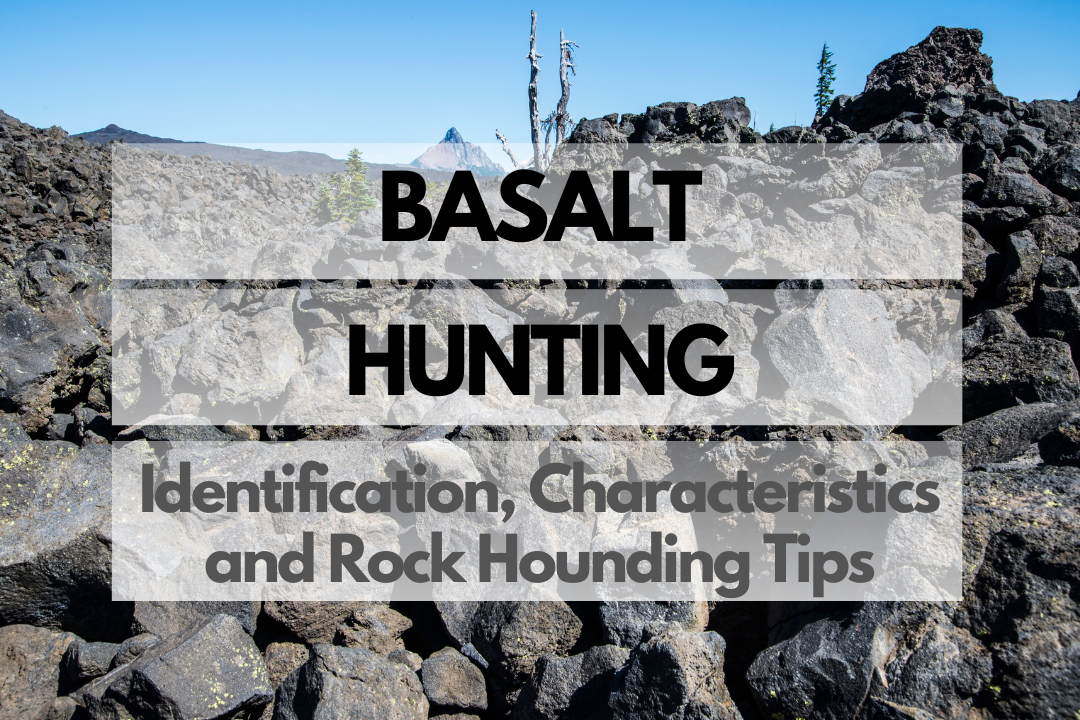Embark on an exciting journey into the world of basalt, one of the most abundant and fascinating rocks on Earth. This guide will explore the history, identification, characteristics, and uses of basalt while providing helpful tips for rock hounding enthusiasts. Get ready to discover the allure and intrigue of this remarkable volcanic rock!
History & Origin of Basalt
Basalt is an igneous rock that forms from the solidification of lava flows rich in iron and magnesium. It makes up the majority of the Earth’s oceanic crust and is also found in vast continental flood basalt provinces. The term “basalt” comes from the Latin word “basaltes,” which was used to describe dark, hard rocks of volcanic origin. Basalt has been utilized by various cultures throughout history for a variety of purposes, including construction, sculpture, and as a source of valuable minerals.
Basalt Identification & Physical Properties
Identifying basalt requires an understanding of its unique physical properties. Here is an overview of some key characteristics to help you recognize this volcanic rock:
| Property | Description |
|---|---|
| Color | Dark gray to black |
| Hardness | 6 to 7 on the Mohs scale |
| Texture | Fine-grained, sometimes with visible phenocrysts |
| Luster | Dull to vitreous |
| Fracture | Conchoidal to uneven |
Basalt Colors
Basalt is typically dark gray to black in color due to its high content of iron and magnesium. The presence of other minerals, such as olivine, can sometimes give basalt a greenish hue. Freshly exposed basalt surfaces may appear shiny or glassy, while weathered surfaces can appear dull or rusty.
Basalt Hardness
Basalt has a hardness of 6 to 7 on the Mohs scale, making it a relatively hard rock. It is more resistant to erosion and weathering than many other types of rock, which contributes to its widespread distribution and use as a building material.
Basalt Types
There are several types of basalt, each with distinct characteristics and formations.
Pillow Basalt
Pillow basalt forms when lava erupts underwater and cools rapidly. The cooling process causes the lava to solidify into rounded, pillow-like shapes. This type of basalt is commonly found along mid-ocean ridges and in ancient oceanic crust that has been uplifted onto land.
Columnar Basalt
Columnar basalt forms when lava cools and contracts, creating a network of vertical, hexagonal columns. This type of basalt is often found in large, thick lava flows and is famous for its striking, geometric formations, such as those found at the Giant’s Causeway in Northern Ireland and Devil’s Tower in Wyoming.
Porphyritic Basalt
Porphyritic basalt contains larger, visible crystals (phenocrysts) embedded in a fine-grained matrix. This texture indicates a two-stage cooling process, with the phenocrysts forming first during slow cooling deep within the Earth, followed by rapid cooling at the surface as the lava erupted and solidified.
Basalt Uses
Basalt has a wide range of applications due to its durability and abundance. Some common uses for basalt include:
- Construction materials, such as aggregate, road base, and building stones
- Landscaping features, such as retaining walls, walkways, and decorative stones
- Sculpture and carving
- Source of minerals, such as olivine and plagioclase feldspar
- Study of Earth’s geological processes and volcanic activity
How Much Is Basalt Worth?
Basalt is not typically considered a valuable rock in terms ofmonetary value due to its abundance and commonality. However, the price of basalt products can vary depending on factors such as size, quality, and processing. For example, basalt landscaping stones may range from $50 to $200 per ton, while polished basalt sculptures could be priced anywhere from a few hundred to several thousand dollars. Ultimately, the worth of basalt is tied to its practical uses and aesthetic appeal rather than its rarity or intrinsic value.
Basalt Rock Hounding Tips
Ready to embark on your basalt rock hounding adventure? Here are some tips and tricks to help you have a successful hunt for this fascinating volcanic rock.
Essential Tools and Equipment
Equipping yourself with the right tools can make a world of difference when hunting for basalt. Some essential tools and equipment include:
- Rock hammer or geologist’s pick for breaking and collecting samples
- Safety goggles to protect your eyes from flying debris
- Sturdy gloves to protect your hands from sharp edges
- Field notebook and pen for recording observations and sample locations
- Hand lens or magnifying glass for close examination of rock textures
- Backpack or rock collecting bag for carrying tools and samples
- GPS or map to help navigate and track sample locations
Safety Tips
Rock hounding can be a fun and rewarding hobby, but safety should always come first. Keep these tips in mind to ensure a safe and enjoyable experience:
- Always wear appropriate safety gear, such as goggles, gloves, and sturdy footwear
- Be aware of your surroundings and avoid unstable terrain or steep cliffs
- Carry a first aid kit and know basic first aid techniques in case of injury
- Stay hydrated and carry enough water for the duration of your excursion
- Notify someone of your plans, including your location and expected return time
- Follow local regulations and respect private property boundaries
Basalt Hunting: Where to Find Basalt
Basalt can be found in many locations around the world, particularly in areas with a history of volcanic activity. Some of the best places to find basalt include mid-ocean ridges, continental flood basalt provinces, and volcanic islands. Here is a table detailing specific sites where you can find basalt:
| Site/Area | City/State/Country |
|---|---|
| Giant’s Causeway | Antrim, Northern Ireland |
| Devil’s Tower | Wyoming, USA |
| Deccan Plateau | India |
| Jeju Island | South Korea |
| Craters of the Moon National Monument | Idaho, USA |
Caring For Your Basalt
Once you’ve collected your basalt samples, proper care and storage will help preserve their natural beauty. Follow these tips for handling and maintaining your basalt:
- Clean your basalt with a soft brush and water to remove dirt and debris
- Avoid using harsh chemicals or abrasives that may damage the rock’s surface
- Store your basalt samples in a cool, dry place away from direct sunlight
- Consider using protective containers or display cases to prevent accidental damage
- Label your samples with relevant information, such as collection date and location
Additional Resources
Expand your knowledge and connect with fellow rock hounds by exploring these helpful resources:
- United States Geological Survey (USGS): https://www.usgs.gov/
- Mindat.org: https://www.mindat.org/
- Rock Tumbling Hobby Forum: https://forum.rocktumblinghobby.com/
- Geology.com: https://geology.com/
- Introduction to Mineralogy and Petrology by S.K. Haldar and J. Josip Tiljar (book)
Additional Basalt FAQs
What are the benefits of Basalt?
Basalt is a versatile rock with a variety of practical uses, including:
- Construction material: Basalt is strong and durable, making it ideal for construction projects such as roadways, buildings, and bridges
- Landscaping: Basalt’s unique appearance adds visual interest to gardens and landscaping projects
- Scientific study: Basalt provides valuable information about Earth’s geological history and volcanic activity
- Artistic applications: Basalt is often used for sculptures and other artistic creations
Do Basalt have any healing properties?
While some people believe that basalt and other rocks possess healing properties, there is no scientific evidence to support these claims. However, many individuals find that engaging in rock hounding and being surrounded by nature can be therapeutic and promote a sense of well-being.
Do Basalt have any spiritual meaning?
In various cultures and belief systems, basalt and other volcanic rocks are often associated with strength, stability, and grounding energy due to their connection with Earth’s inner processes. However, the spiritual significance of basalt is subjective and may vary from person to person.
Do I need a permit to go Basalt hunting?
Permit requirements for rock hounding vary depending on the location and type of land you plan to explore. In the United States, some public lands managed by the Bureau of Land Management (BLM) and the United States Forest Service (USFS) allow rock hounding without a permit for personal, non-commercial use. However, it’s essential to check local regulations and obtain any necessary permits before heading out. Visit the BLM website (https://www.blm.gov/) and the USFS website (https://www.fs.usda.gov/) for more information on rock hounding on public lands.
Closing Thoughts
Embarking on a basalt rock hounding adventure can be an exciting and rewarding experience. With the right tools, safety precautions, and knowledge of where to find basalt, you’ll be well on your way to building an impressive collection. So, gather your gear, explore the great outdoors, and discover the fascinating world of basalt and other volcanic rocks. Happy hunting!

